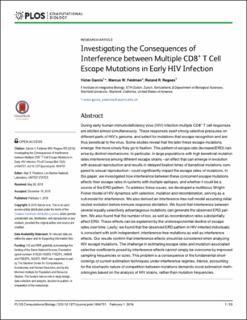Please use this identifier to cite or link to this item:
https://doi.org/10.21256/zhaw-4703| Publication type: | Article in scientific journal |
| Type of review: | Peer review (publication) |
| Title: | Investigating the consequences of interference between multiple CD8+ T cell escape mutations in early HIV infection |
| Authors: | Garcia, Victor Feldman, Marcus W. Regoes, Roland R. |
| DOI: | 10.21256/zhaw-4703 10.1371/journal.pcbi.1004721 |
| Published in: | PLOS Computational Biology |
| Volume(Issue): | 12 |
| Issue: | 2 |
| Page(s): | 1 |
| Pages to: | 23 |
| Issue Date: | Feb-2016 |
| Publisher / Ed. Institution: | Public Library of Science |
| ISSN: | 1553-7358 1553-7358 |
| Language: | English |
| Subjects: | CD8+ T-Lymphocytes; Computational biology; Epitopes, T-Lymphocyte; Molecular evolution; HIV infections; HIV-1; Humans; Immune evasion |
| Subject (DDC): | 571: Physiology and related subjects |
| Abstract: | During early human immunodeficiency virus (HIV) infection multiple CD8+ T cell responses are elicited almost simultaneously. These responses exert strong selective pressures on different parts of HIV's genome, and select for mutations that escape recognition and are thus beneficial to the virus. Some studies reveal that the later these escape mutations emerge, the more slowly they go to fixation. This pattern of escape rate decrease(ERD) can arise by distinct mechanisms. In particular, in large populations with high beneficial mutation rates interference among different escape strains – an effect that can emerge in evolution with asexual reproduction and results in delayed fixation times of beneficial mutations compared to sexual reproduction – could significantly impact the escape rates of mutations. In this paper, we investigated how interference between these concurrent escape mutations affects their escape rates in systems with multiple epitopes, and whether it could be a source of the ERD pattern. To address these issues, we developed a multilocus Wright-Fisher model of HIV dynamics with selection, mutation and recombination, serving as a null-model for interference. We also derived an interference-free null model assuming initial neutral evolution before immune response elicitation. We found that interference between several equally selectively advantageous mutations can generate the observed ERD pattern. We also found that the number of loci, as well as recombination rates substantially affect ERD. These effects can be explained by the underexponential decline of escape rates over time. Lastly, we found that the observed ERD pattern in HIV infected individuals is consistent with both independent, interference-free mutations as well as interference effects. Our results confirm that interference effects should be considered when analyzing HIV escape mutations. The challenge in estimating escape rates and mutation-associated selective coefficients posed by interference effects cannot simply be overcome by improved sampling frequencies or sizes. This problem is a consequence of the fundamental shortcomings of current estimation techniques under interference regimes. Hence, accounting for the stochastic nature of competition between mutations demands novel estimation methodologies based on the analysis of HIV strains, rather than mutation frequencies. |
| URI: | https://digitalcollection.zhaw.ch/handle/11475/10498 |
| Fulltext version: | Published version |
| License (according to publishing contract): | CC BY 4.0: Attribution 4.0 International |
| Departement: | Life Sciences and Facility Management |
| Organisational Unit: | Institute of Computational Life Sciences (ICLS) |
| Appears in collections: | Publikationen Life Sciences und Facility Management |
Files in This Item:
| File | Description | Size | Format | |
|---|---|---|---|---|
| journal.pcbi.1004721.PDF | Garcia et al., Plos Comp Biol, 2016 | 1.58 MB | Adobe PDF |  View/Open |
Show full item record
Garcia, V., Feldman, M. W., & Regoes, R. R. (2016). Investigating the consequences of interference between multiple CD8+ T cell escape mutations in early HIV infection. PLOS Computational Biology, 12(2), 1–23. https://doi.org/10.21256/zhaw-4703
Garcia, V., Feldman, M.W. and Regoes, R.R. (2016) ‘Investigating the consequences of interference between multiple CD8+ T cell escape mutations in early HIV infection’, PLOS Computational Biology, 12(2), pp. 1–23. Available at: https://doi.org/10.21256/zhaw-4703.
V. Garcia, M. W. Feldman, and R. R. Regoes, “Investigating the consequences of interference between multiple CD8+ T cell escape mutations in early HIV infection,” PLOS Computational Biology, vol. 12, no. 2, pp. 1–23, Feb. 2016, doi: 10.21256/zhaw-4703.
GARCIA, Victor, Marcus W. FELDMAN und Roland R. REGOES, 2016. Investigating the consequences of interference between multiple CD8+ T cell escape mutations in early HIV infection. PLOS Computational Biology. Februar 2016. Bd. 12, Nr. 2, S. 1–23. DOI 10.21256/zhaw-4703
Garcia, Victor, Marcus W. Feldman, and Roland R. Regoes. 2016. “Investigating the Consequences of Interference between Multiple CD8+ T Cell Escape Mutations in Early HIV Infection.” PLOS Computational Biology 12 (2): 1–23. https://doi.org/10.21256/zhaw-4703.
Garcia, Victor, et al. “Investigating the Consequences of Interference between Multiple CD8+ T Cell Escape Mutations in Early HIV Infection.” PLOS Computational Biology, vol. 12, no. 2, Feb. 2016, pp. 1–23, https://doi.org/10.21256/zhaw-4703.
Items in DSpace are protected by copyright, with all rights reserved, unless otherwise indicated.